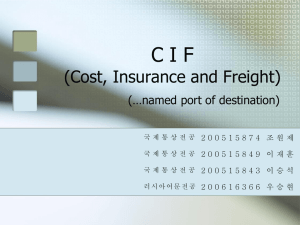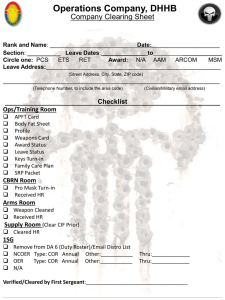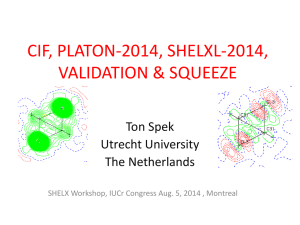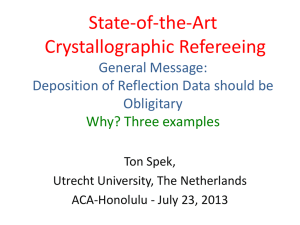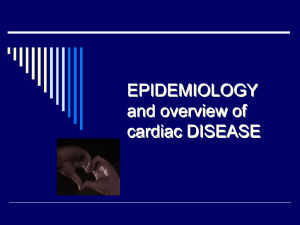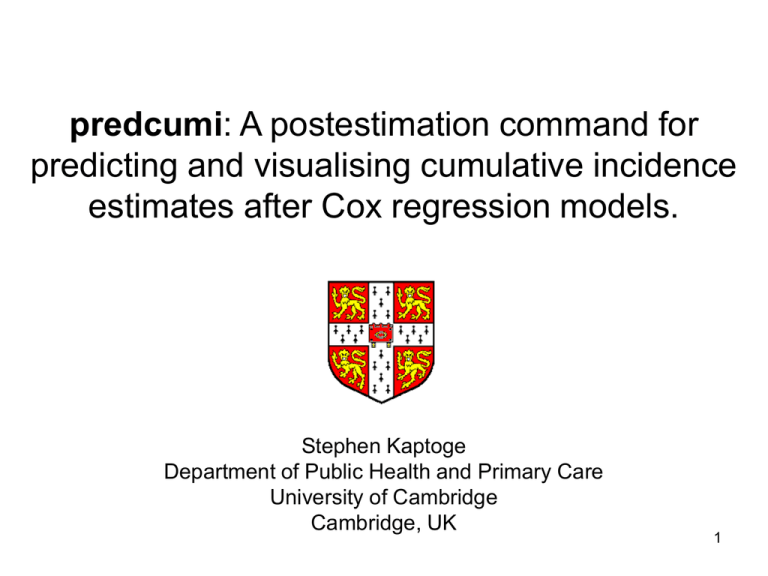
predcumi: A postestimation command for
predicting and visualising cumulative incidence
estimates after Cox regression models.
Stephen Kaptoge
Department of Public Health and Primary Care
University of Cambridge
Cambridge, UK
1
Outline
•
Background.
–
–
–
–
•
What motivated this work.
Competing risks: Survival vs. cumulative incidence function (CIF).
Cause-specific hazard formulation of competing risk models.
Competing risk models in Stata (what was missing).
Implementation of predcumi
– Syntax.
– Programming aspects.
•
Examples: CVD risk prediction
– Cumulative incidence over observed times vs. within landmark times.
– Graphical visualisation of the unadjusted/adjusted probabilities.
– Comparison of covariate adjusted CIF vs. previous implementations.
•
Remarks.
2
Motivation
• Involved in meta-analysis of individual participant data
from multiple studies in cardiovascular disease (CVD).
– CVD is a composite endpoint, comprising CHD and Stroke
(each with further subtypes).
– Aetiological associations suggest some risk factors (e.g. lipids)
have stronger associations with CHD and others (e.g. blood
pressure) have stronger associations with stroke.
– Yet it is somewhat traditional to analyse the composite CVD
endpoint for risk prediction purposes.
• Question: Could disaggregation of prediction models
for CVD to CHD and stroke components possibly lead
to better predictions for the composite CVD outcome?
– What about adjustment for other competing risks (e.g. nonCVD death)?
3
Competing risks (CR)
• Competing risks (e.g. death from other cause) prevent
the event of interest from occurring altogether.
– Hence, CRs should be handled differently from censoring
when interest is on making absolute risk predictions.
– Otherwise will overestimate the absolute risk of the event of
interest.
• Kaplan-Meier failure estimates (sts generate) or
absolute risk predictions from Cox models (stcox) do
not account for competing risks …
– But the stcox model provides cause-specific hazards (CSH),
the fundamental quantities needed for calculating cumulative
incidence to account for competing risks.
4
CSH, survival, and cumulative incidence
• Cause-specific hazard (CSH) hk(t): the hazard of failing
from a specific cause (k) in the presence of competing
risks.
Prob(t T t t, D k | T t )
hk (t ) lim
t
t 0
• Cumulative hazard Hk(t) and Survival Sk(t), S(t):
Hk (t )
h (t )
j :t j t
k
j
K
S(t ) exp Hk (t )
k 1
Sk (t ) exp Hk (t )
• Cumulative incidence function (CIF) Ik(t):
I k (t )
h (t )S(t
j :t j t
k
j
j 1
Overall survival
)
• hk(t) is obtained after stcox using --predict, basehc-followed by careful sorting and summations by strata.
Putter H et al Statist Med 2007(26)2389–2430 5
Back to motivating problem …
• Planned to disaggregate the prediction of absolute risk
of CVD to CHD and stroke components, treating both
as competing events.
– Calculate CIF of the composite CVD endpoint as sum of the
predicted CIFs for CHD and stroke.
– Additionally treat non-CVD deaths as competing risks.
– Compare the predictions from the above approaches by
calculating discrimination measures (e.g. C-index).
• Needed a program that could calculate the covariateadjusted CIF over observed failure times, as well as
the maximum within user-specified landmark times
(e.g. 10-years) for each individual in the dataset.
6
Competing risk models in Stata
(what was missing)
• User-written programs by Enzo Coviello (stcompet
and stcompadj), could only provide CIFs over time
adjusted to specific covariate values.
• stcrreg was formulated differently than the stcox
model used for inference of hazard ratios (and was
also difficult to converge in large datasets).
• Solution: Write a bespoke postestimation program that
calculates covariate adjusted CIFs after stcox model
(predcumi), including graphical visualisation.
7
--predcumi-- Implementation
•
Assumes fitted Cox model is for event of interest and gets the
specification from e(cmdline).
•
User provides specification of the competing event(s) via options
compete(string) or compvars(varlist) and compcodes(numlist).
•
--predcumi-- then refits the model for each endpoint to obtain the
cause-specific baseline hazards, cause-specific linear predictor,
overall baseline survival, and overall linear predictor.
•
It then summates hk(tj)*exp(xbk)*S0(tj-1)^exp(xb) product over time
by strata to obtain the CIF for each distinct covariate pattern.
– This summation part implemented in mata, hence faster than adofile.
•
If attimes(numlist) option is specified, it calculates the maximum
CIF over each landmark time in attimes().
8
--predcumi-- Syntax
predcumi [if exp] [in range] [ , compvars(varlist)
compcodes(numlist) compete(string) attimes(numlist
integer >0) lifetimes(numlist integer >0) nograph
nodots adjust(string) xvar(varname) compare(varlist)
nobaseline nobytime graph_options ]
• Currently uses default output variable names xb*, s0*,
hc*, cumhc*, pf*, cif* where * = 1, 2, 3, … endpoints, to
save the predictions, but will make flexible in the future.
• adjust(string) options can be either #, mean, p1, p5,
p10, p25, p50, p75, p90, p95, p99, or round(#), in
which case the adjusted CIF calculations are done
after fixing the covariates at the values specified.
9
Example 1: CVD risk prediction
Contains data from data\predcumi_demo_data.dta
obs:
817
vars:
15
11 Sep 2012 15:28
-------------------------------------------------------------------------------storage display
value
variable name
type
format
label
variable label
-------------------------------------------------------------------------------cohort
str7
%9s
Cohort abbreviation
subjectid
str3
%9s
Subject ID
sex
byte
%8.0g
sex
Sex
duration
float %9.0g
Time to event/censoring (yrs)
ep_chdmi
byte
%9.0g
CHD
ep_crbv
byte
%8.0g
Stroke
ep_cvd
byte
%9.0g
CVD (CHD or stroke)
ep_ncv_f
byte
%9.0g
Non-CVD death
ep_dead
byte
%9.0g
Any death
ages
float %9.0g
Age at survey (yrs)
smallbin
byte
%9.0g
statbin
Smoking status
sbp
int
%8.0g
SBP (mmHg)
hxdiabbin
byte
%17.0g
hx
History of diabetes
tchol
float %9.0g
Total cholesterol (mmol/l)
hdl
float %9.0g
HDL-C (mmol/l)
-------------------------------------------------------------------------------Sorted by: cohort subjectid
10
Data descriptive statistics
Variable |
Obs
Mean
Std. Dev.
Min
Max
-------------+-------------------------------------------------------cohort |
0
subjectid |
0
sex |
817
1.512852
.500141
1
2
sexbin |
817
.5128519
.500141
0
1
duration |
817
16.74673
5.693721
.0821355
20.4627
-------------+-------------------------------------------------------ages |
817
57.85982
11.38797
40
80.096
smallbin |
817
.2423501
.4287675
0
1
sbp |
817
145.1004
21.50535
91
230
hxdiabbin |
817
.0330477
.1788707
0
1
tchol |
817
5.727442
1.028323
3.08
10.24
hdl |
817
1.473035
.3640861
.7
2.97
-------------+-------------------------------------------------------variable |
N
sum
-------------+----------------------------------------ep_chdmi |
817
66 CHD
ep_crbv |
817
63 Stroke
ep_cvd |
817
129 CVD (CHD or stroke)
ep_ncv_f |
817
157 Non-CVD death
ep_dead |
817
240 Any death
------------------------------------------------------11
KM failure estimates
KM failure: CHD
KM failure: Stroke
0.40
0.40
0.30
0.30
0.20
0.20
0.10
0.10
0.00
0.00
0
5
10
analysis time
sex = Male
15
20
0
sex = Female
KM failure: CVD (CHD or stroke)
0.30
0.30
0.20
0.20
0.10
0.10
0.00
0.00
10
analysis time
sex = Male
15
sex = Female
15
20
sex = Female
KM failure: Non-CVD death
0.40
5
10
analysis time
sex = Male
0.40
0
5
20
0
5
10
analysis time
sex = Male
15
sex = Female
20
12
User-fitted CHD model (event of interest)
. stset duration, failure("ep_chdmi == 1")
. xi: stcox ages smallbin sbp hxdiabbin tchol hdl, strata(sex) nolog
failure _d: ep_chdmi == 1
analysis time _t: duration
Stratified Cox regr. -- Breslow method for ties
No. of subjects =
817
No. of failures =
66
Time at risk
= 13682.08051
Number of obs
=
817
LR chi2(6)
=
89.58
Log likelihood =
-338.07286
Prob > chi2
=
0.0000
-----------------------------------------------------------------------------_t | Haz. Ratio
Std. Err.
z
P>|z|
[95% Conf. Interval]
-------------+---------------------------------------------------------------ages |
1.085469
.0150106
5.93
0.000
1.056444
1.115292
smallbin |
2.101201
.6167235
2.53
0.011
1.182038
3.735113
sbp |
1.023793
.0060849
3.96
0.000
1.011936
1.035788
hxdiabbin |
1.883857
.8553814
1.39
0.163
.773664
4.587153
tchol |
1.041145
.128146
0.33
0.743
.8179821
1.325191
hdl |
1.17283
.3919691
0.48
0.633
.6091954
2.257945
-----------------------------------------------------------------------------Stratified by sex
13
--predcumi-- Model 1 (CHD)
. predcumi, compvars("ep_crbv ep_ncv_f") compcodes(1) attimes(10)
failure _d: ep_chdmi == 1
analysis time _t: duration
Stratified Cox regr. -- Breslow method for ties
No. of subjects =
817
No. of failures =
66
Time at risk
= 13682.08051
Number of obs
=
817
LR chi2(6)
=
89.58
Log likelihood =
-338.07286
Prob > chi2
=
0.0000
-----------------------------------------------------------------------------_t | Haz. Ratio
Std. Err.
z
P>|z|
[95% Conf. Interval]
-------------+---------------------------------------------------------------ages |
1.085469
.0150106
5.93
0.000
1.056444
1.115292
smallbin |
2.101201
.6167235
2.53
0.011
1.182038
3.735113
sbp |
1.023793
.0060849
3.96
0.000
1.011936
1.035788
hxdiabbin |
1.883857
.8553814
1.39
0.163
.773664
4.587153
tchol |
1.041145
.128146
0.33
0.743
.8179821
1.325191
hdl |
1.17283
.3919691
0.48
0.633
.6091954
2.257945
-----------------------------------------------------------------------------Stratified by sex
Duplicates in terms of sex _t0 _t hc1
dupl1 |
Freq.
Percent
Cum.
------------+----------------------------------0 |
60
90.91
90.91
1 |
6
9.09
100.00
------------+----------------------------------Total |
66
100.00
14
--predcumi-- Model 2 (Stroke)
-> stset duration, failure(ep_crbv==1)
failure _d: ep_crbv == 1
analysis time _t: duration
Stratified Cox regr. -- Breslow method for ties
No. of subjects =
817
No. of failures =
63
Time at risk
= 13682.08051
Number of obs
=
817
LR chi2(6)
=
45.67
Log likelihood =
-341.26046
Prob > chi2
=
0.0000
-----------------------------------------------------------------------------_t | Haz. Ratio
Std. Err.
z
P>|z|
[95% Conf. Interval]
-------------+---------------------------------------------------------------ages |
1.080394
.0146957
5.68
0.000
1.051971
1.109584
smallbin |
1.239853
.3939733
0.68
0.499
.6651106
2.311247
sbp |
1.004778
.0065243
0.73
0.463
.9920712
1.017647
hxdiabbin |
1.123873
.6831708
0.19
0.848
.341425
3.699464
tchol |
.9629966
.1232594
-0.29
0.768
.7493327
1.237584
hdl |
.6935387
.2667539
-0.95
0.341
.3263438
1.473893
-----------------------------------------------------------------------------Stratified by sex
Duplicates in terms of sex _t0 _t hc2
dupl2 |
Freq.
Percent
Cum.
------------+----------------------------------0 |
57
90.48
90.48
1 |
6
9.52
100.00
------------+----------------------------------Total |
63
100.00
15
--predcumi-- Model 3 (Non-CVD death)
-> stset duration, failure(ep_ncv_f==1)
failure _d: ep_ncv_f == 1
analysis time _t: duration
Stratified Cox regr. -- Breslow method for ties
No. of subjects =
817
No. of failures =
157
Time at risk
= 13682.08051
Number of obs
=
817
LR chi2(6)
=
175.09
Log likelihood =
-822.29807
Prob > chi2
=
0.0000
-----------------------------------------------------------------------------_t | Haz. Ratio
Std. Err.
z
P>|z|
[95% Conf. Interval]
-------------+---------------------------------------------------------------ages |
1.105477
.0099111
11.18
0.000
1.086221
1.125074
smallbin |
1.661562
.3161485
2.67
0.008
1.144344
2.412549
sbp |
.9982142
.0041068
-0.43
0.664
.9901974
1.006296
hxdiabbin |
1.981136
.6249526
2.17
0.030
1.067583
3.676438
tchol |
.8962753
.0760461
-1.29
0.197
.7589614
1.058432
hdl |
1.454097
.3178565
1.71
0.087
.9473837
2.231828
-----------------------------------------------------------------------------Stratified by sex
Duplicates in terms of sex _t0 _t hc3
dupl3 |
Freq.
Percent
Cum.
------------+----------------------------------0 |
109
69.43
69.43
1 |
32
20.38
89.81
2 |
12
7.64
97.45
3 |
4
2.55
100.00
------------+----------------------------------Total |
157
100.00
16
--predcumi-- Model 4 (Any event)
-> stset duration, failure(__000002)
failure _d: __000002
analysis time _t: duration
Stratified Cox regr. -- Breslow method for ties
No. of subjects =
817
No. of failures =
286
Time at risk
= 13682.08051
Number of obs
=
817
LR chi2(6)
=
290.60
Log likelihood =
-1511.4978
Prob > chi2
=
0.0000
-----------------------------------------------------------------------------_t | Haz. Ratio
Std. Err.
z
P>|z|
[95% Conf. Interval]
-------------+---------------------------------------------------------------ages |
1.094803
.0071982
13.78
0.000
1.080785
1.109002
smallbin |
1.636837
.2329696
3.46
0.001
1.238382
2.163496
sbp |
1.006025
.0030151
2.00
0.045
1.000133
1.011952
hxdiabbin |
1.789991
.4242442
2.46
0.014
1.124885
2.84835
tchol |
.9462233
.0580374
-0.90
0.367
.8390435
1.067094
hdl |
1.187661
.1965384
1.04
0.299
.8586825
1.642678
-----------------------------------------------------------------------------Stratified by sex
Duplicates in terms of sex _t0 _t hc
dupl |
Freq.
Percent
Cum.
------------+----------------------------------0 |
144
50.35
50.35
1 |
94
32.87
83.22
2 |
36
12.59
95.80
3 |
12
4.20
100.00
------------+----------------------------------Total |
286
100.00
17
--predcumi-- Model 1 CIF over time
Calculating cumulative incidence of ep_chdmi over time among 817 subjects
in 2 strata at 817 linear predictor values
Stratum = 1 (Male), n = 398, and 398 linear predictors
..................................................
50
..................................................
100
..................................................
150
..................................................
200
..................................................
250
..................................................
300
..................................................
350
................................................
Stratum = 2 (Female), n = 419, and 419 linear predictors
..................................................
50
..................................................
100
..................................................
150
..................................................
200
..................................................
250
..................................................
300
..................................................
350
..................................................
400
...................
18
--predcumi-- Model 1 CIF up to time 10
Calculating cumulative incidence of ep_chdmi at time = 10
in 2 strata
Stratum = 1 (Male), n = 398, and 398 linear predictors
..................................................
50
..................................................
100
..................................................
150
..................................................
200
..................................................
250
..................................................
300
..................................................
350
................................................
Stratum = 2 (Female), n = 419, and 419 linear predictors
..................................................
50
..................................................
100
..................................................
150
..................................................
200
..................................................
250
..................................................
300
..................................................
350
..................................................
400
...................
… and similarly for each of Model 2 (Stroke) and Model 3 (Non-CVD death)
Execution time = 4 sec for calculations + 12 sec for graphs
19
--predcumi-- Output variables (default)
Generated variables
storage display
value
variable name
type
format
label
variable label
---------------------------------------------------------------------------------xb1
double %10.0g
Linear prediction CHD
xb2
double %10.0g
Linear prediction Stroke
xb3
double %10.0g
Linear prediction Non-CVD death
xb
double %10.0g
Linear prediction overall
cif01
double %10.0g
Baseline CIF CHD
cif1
double %10.0g
Predicted CIF | xb CHD
cif01t10
double %10.0g
Baseline CIF (T <= 10) CHD
cif1t10
double %10.0g
Predicted CIF (T <= 10) CHD
cif02
double %10.0g
Baseline CIF Stroke
cif2
double %10.0g
Predicted CIF | xb Stroke
cif02t10
double %10.0g
Baseline CIF (T <= 10) Stroke
cif2t10
double %10.0g
Predicted CIF (T <= 10) Stroke
cif03
double %10.0g
Baseline CIF Non-CVD death
cif3
double %10.0g
Predicted CIF | xb Non-CVD death
cif03t10
double %10.0g
Baseline CIF (T <= 10) Non-CVD death
cif3t10
double %10.0g
Predicted CIF (T <= 10) Non-CVD death
pf1
double %10.0g
Cox Pr(failure) CHD
pf1t10
double %10.0g
Cox Pr(T <= 10) CHD
pf2
double %10.0g
Cox Pr(failure) Stroke
pf2t10
double %10.0g
Cox Pr(T <= 10) Stroke
pf3
double %10.0g
Cox Pr(failure) Non-CVD death
pf3t10
double %10.0g
Cox Pr(T <= 10) Non-CVD death
pf
double %10.0g
Cox Pr(failure) overall
20
pft10
double %10.0g
Cox Pr(T <= 10) overall
Baseline CIF and predicted CIF vs. time
.000015
.25
Predicted CIF | xb CHD
.2
.00001
5.000e-06
.15
.1
.05
0
0
0
5
10
_t
Male
15
Female
20
0
5
10
_t
Male
15
20
Female
21
Cox Pr(failure) and predicted CIF vs. time
Male
Female
Male
Female
.8
.4
.6
Probability
.3
.4
.2
.2
.1
0
0
0
5
10
15
20
0
5
10
15
20
0
5
10
15
_t
Cox Pr(failure) CHD
20
0
5
10
15
20
_t
Predicted CIF | xb CHD
Cox Pr(failure) Stroke
Graphs by group(sex)
Predicted CIF | xb Stroke
Graphs by group(sex)
Male
Female
.8
.6
.4
.2
0
0
5
10
15
20
0
5
10
15
20
_t
Cox Pr(failure) Non-CVD death
Graphs by group(sex)
Predicted CIF | xb Non-CVD death
22
Cox Pr(failure) and predicted CIF vs. linear predictor
Male
Female
Male
.25
.4
.2
Probability
.5
.3
.2
Female
.15
.1
.1
.05
0
0
6
8
10
12
6
8
10
12
3
4
Linear prediction CHD
Cox Pr(T <= 10) CHD
5
6
7
3
4
5
6
7
Linear prediction Stroke
Predicted CIF (T <= 10) CHD
Cox Pr(T <= 10) Stroke
Graphs by group(sex)
Predicted CIF (T <= 10) Stroke
Graphs by group(sex)
Male
Female
.8
.6
.4
.2
0
4
6
8
10
4
6
8
10
Linear prediction Non-CVD death
Cox Pr(T <= 10) Non-CVD death
Graphs by group(sex)
Predicted CIF (T <= 10) Non-CVD death
23
DIY combined summary of the predicted CIFs vs. age
Male
Female
.5
.4
.3
.2
.1
0
40
50
60
70
80
40
50
60
70
80
Age at survey (yrs)
Predicted CIF (T <= 10) CHD
Predicted CIF (T <= 10) Non-CVD death
Predicted CIF (T <= 10) Overall
Predicted CIF (T <= 10) Stroke
Predicted CIF (T <= 10) CVD
Graphs by Sex
Where: CIFCVD = CIFCHD + CIFStroke
CIFOverall = CIFCHD + CIFStroke + CIFNon-CVD
24
--predcumi-- Covariate adjusted CIF (1)
. predcumi, compvars("ep_crbv ep_ncv_f") compcodes(1) attimes(10) ///
adjust(smallbin = 0 sbp = mean hxdiabbin = 0 tchol = mean hdl = mean) ///
xvar(ages) nobaseline nobytime
< output omitted, same models as described before >
Adjusting
Adjusting
Adjusting
Adjusting
Adjusting
Adjusting
covariates to specified values ...
smallbin
= 0
sbp
= 145.1003671970624
hxdiabbin
= 0
tchol
= 5.727441867678956
hdl
= 1.473035494437854
(mean)
(mean)
(mean)
Unadjusted variables ages
Variable |
Obs
Mean
Std. Dev.
Min
Max
-------------+-------------------------------------------------------ages |
817
57.85982
11.38797
40
80.096
Calculating cumulative incidence of ep_chdmi at time = 10
in 2 strata
Stratum = 1 (Male), n = 398, and 40 linear predictors
........................................
Stratum = 2 (Female), n = 419, and 42 linear predictors
..........................................
… and similarly for each of Model 2 (Stroke) and Model 3 (Non-CVD death)
Execution time = 1 sec for calculations + 6 sec for graphs
25
DIY combined summary of the predicted CIFs vs. age
Male
Female
.4
.3
.2
.1
0
40
50
60
70
80
40
50
60
70
80
Age at survey (yrs)
Predicted CIF (T <= 10) CHD
Predicted CIF (T <= 10) Non-CVD death
Predicted CIF (T <= 10) Overall
Predicted CIF (T <= 10) Stroke
Predicted CIF (T <= 10) CVD
Graphs by Sex
Where: CIFCVD = CIFCHD + CIFStroke
CIFOverall = CIFCHD + CIFStroke + CIFNon-CVD
26
--predcumi-- Covariate adjusted CIF (2)
. predcumi, compvars("ep_crbv ep_ncv_f") compcodes(1) attimes(10) ///
adjust(sbp = p95 hxdiabbin = 0 tchol = p95 hdl = p5) ///
xvar(ages) nobaseline nobytime compare(smallbin)
< output omitted, same models as described before >
Adjusting covariates to specified values ...
Adjusting sbp
= 183
Adjusting hxdiabbin
= 0
Adjusting tchol
= 7.46999979019165
Adjusting hdl
= .9599999785423279
Unadjusted variables ages smallbin
(p95)
(p95)
(p5)
Variable |
Obs
Mean
Std. Dev.
Min
Max
-------------+-------------------------------------------------------ages |
817
57.85982
11.38797
40
80.096
smallbin |
817
.2423501
.4287675
0
1
Calculating cumulative incidence of ep_chdmi at time = 10
in 2 strata
Stratum = 1 (Male), n = 398, and 78 linear predictors
..................................................
50
............................
Stratum = 2 (Female), n = 419, and 71 linear predictors
..................................................
50
.....................
… and similarly for each of Model 2 (Stroke) and Model 3 (Non-CVD death)
27
DIY combined summary of the predicted CIFs vs. age
Male, Other
Male, Current
Female, Other
Female, Current
.4
.3
.2
.1
0
40
50
60
70
80 40
50
60
70
80 40
50
60
70
80 40
50
60
70 80
Age at survey (yrs)
Predicted CIF (T <= 10) CHD
Predicted CIF (T <= 10) Non-CVD death
Predicted CIF (T <= 10) Overall
Predicted CIF (T <= 10) Stroke
Predicted CIF (T <= 10) CVD
Graphs by Sex and Smoking status
Where: CIFCVD = CIFCHD + CIFStroke
CIFOverall = CIFCHD + CIFStroke + CIFNon-CVD
28
Check against --stcompet-- (unadjusted)
stset duration, failure("cause == 1")
xi: stcox, strata(sex) estimate nolog
predcumi, compete("cause == 2")
stcompet cumi = ci, compet1(2) by(sex)
foreach m of numlist 1 2 {
overlay cif`m' _t, over(sex) ms(i i) c(J) ylabel(#5, angle(horiz)) ///
scheme("s1color_sk") addplot(scatter cumi _t if cause == `m', ms(+))
name(gr1_cause`m', replace)
}
.2
.25
Plus (+) --stcompet-- estimates
Line ( ̶ ) --predcumi-- estimates
Predicted CIF | xb Non-CVD death
.
.
.
.
.15
.1
.05
Plus (+) --stcompet-- estimates
Line ( ̶ ) --predcumi-- estimates
.2
.15
.1
.05
0
0
0
5
10
_t
Male
15
Female
20
0
5
10
_t
Male
15
Female
20
29
Check against --stcompadj-- (adjusted)
stset duration, failure("cause == 1")
xi: stcox sexbin ages, nolog
predcumi, compete("cause==2") adjust(ages = 50)
local fitopts = "maineffect(sexbin ages) competeffect(sexbin ages) showmod"
stcompadj sexbin=0 ages = 50, compet(2) gen(cifmain0 cifcomp0) `fitopts'
stcompadj sexbin=1 ages = 50, compet(2) gen(cifmain1 cifcomp1) `fitopts'
foreach m of numlist 1 2 {
local compvars = cond(`m' == 1, "cifmain*", "cifcomp*")
overlay cif`m' _t, over(sexbin) ms(i i) c(J) ylabel(#5, angle(horiz)) ///
scheme("s1color_sk") addplot(scatter `compvars' _t if cause == `m', ms(+ +))
name (gr3_cause`m', replace)
}
.1
Plus (+) --stcompadj-- estimates
Line ( ̶ ) --predcumi-- estimates
.08
.06
.04
.02
Plus (+) --stcompadj-- estimates
Line ( ̶ ) --predcumi-- estimates
.1
Predicted CIF | xb Non-CVD death
.
.
.
.
.
.
.08
.06
.04
.02
0
0
0
5
10
_t
Male
15
Female
20
0
5
10
_t
Male
15
Female
20
30
Check against --stcrreg-- (adjusted)
.
.
.
.
stset duration, failure("cause == 1")
xi: stcox sexbin ages, nolog
predcumi, compete("cause==2") adjust(ages = 50)
foreach m of numlist 1 2 {
levelsof cause if !inlist(cause, 0, `m'), local(compevent)
stset duration, failure("cause == `m'")
xi: stcrreg sexbin ages, compete(cause == `compevent') iterate(20)
local atval1 = "at1(sexbin = 0 ages = 50) at2(sexbin = 1 ages = 50)"
forvalues k = 1/1 {
local gropts = `"title("") ylabel(#5, angle(horiz))"'
local atvals "`atval`k''"
local addplot = "scatter cif`m' _t, ms(+)"
stcurve, cif `atvals' `gropts' addplot(`addplot') ///
legend(order(1 2)) name(gr4at`k'_cause`m', replace)
}
}
No likelihood convergence after 20 iterations, for either model …!
31
Check against --stcrreg-- Model 1
failure _d: cause == 1
analysis time _t: duration
Iteration 0:
log pseudolikelihood
Iteration 1:
log pseudolikelihood
Iteration 2:
log pseudolikelihood
Iteration 3:
log pseudolikelihood
Iteration 4:
log pseudolikelihood
Iteration 5:
log pseudolikelihood
Iteration 6:
log pseudolikelihood
...
Iteration 20: log pseudolikelihood
convergence not achieved
=
=
=
=
=
=
=
-821.17236
-817.56789
-817.52155
-817.49062
-817.48983
-817.4896
-817.48958
= -817.48958
(not
(not
(not
(not
(not
(not
(not
concave)
concave)
concave)
concave)
concave)
concave)
concave)
(not concave)
Competing-risks regression
No. of obs
=
817
No. of subjects =
817
Failure event : cause == 1
No. failed
=
129
Competing event: cause == 2
No. competing
=
157
No. censored
=
531
Wald chi2(0)
=
.
Log pseudolikelihood = -817.48958
Prob > chi2
=
.
-----------------------------------------------------------------------------|
Robust
_t |
SHR
Std. Err.
z
P>|z|
[95% Conf. Interval]
-------------+---------------------------------------------------------------sexbin |
.8124038
.
.
.
.
.
ages |
1.068916
.
.
.
.
.
------------------------------------------------------------------------------
32
Check against --stcrreg-- Model 2
failure _d: cause == 2
analysis time _t: duration
Iteration 0:
log pseudolikelihood
Iteration 1:
log pseudolikelihood
Iteration 2:
log pseudolikelihood
Iteration 3:
log pseudolikelihood
Iteration 4:
log pseudolikelihood
Iteration 5:
log pseudolikelihood
Iteration 6:
log pseudolikelihood
...
Iteration 20: log pseudolikelihood
convergence not achieved
=
=
=
=
=
=
=
-971.95067
-969.46089
-969.38712
-969.35333
-969.35262
-969.35261
-969.3526
=
-969.3526
(not
(not
(not
(not
(not
(not
(not
concave)
concave)
concave)
concave)
concave)
concave)
concave)
(not concave)
Competing-risks regression
No. of obs
=
817
No. of subjects =
817
Failure event : cause == 2
No. failed
=
157
Competing event: cause == 1
No. competing
=
129
No. censored
=
531
Wald chi2(0)
=
.
Log pseudolikelihood = -969.3526
Prob > chi2
=
.
-----------------------------------------------------------------------------|
Robust
_t |
SHR
Std. Err.
z
P>|z|
[95% Conf. Interval]
-------------+---------------------------------------------------------------sexbin |
.5422991
.
.
.
.
.
ages |
1.08355
.
.
.
.
.
------------------------------------------------------------------------------
33
Check against --stcrreg-- (iteration 20!)
• Just for fun … based on these estimates …
Plus (+) --predcumi-- estimates
Line ( ̶ ) --stcrreg-- estimates
.08
.06
.04
.02
Plus (+) --predcumi-- estimates
Line ( ̶ ) --stcrreg-- estimates
.1
Cumulative Incidence Non-CVD death
.1
.08
.06
.04
.02
0
0
0
5
10
analysis time
sexbin = 0 ages = 50
15
sexbin = 1 ages = 50
20
0
5
10
analysis time
sexbin = 0 ages = 50
15
20
sexbin = 1 ages = 50
34
Remarks
• --predcumi-- provides some added functionality not
addressed in previous user-written programs, i.e.
individual predictions and CIF within landmark times.
– Ongoing considerations include extension to lifetime-risk
calculation with age-as-timescale models.
• --stcompet-- and --stcompadj--, however, do a lot
more with respect to covariate adjusted CIF estimates,
including confidence intervals, hypothesis testing, and
CIF inferences based on flexible parametric models.
– Also discovered during this meeting that --stpm2-- has a
wrapper function --stpm2cif-- for adjusted CIF calculations.
• For large datasets, competing risk models based on
cause-specific hazards could be more tractable than
currently possible with --stcrreg-- (??)
35
Acknowledgements
• Mentors
– S Thompson, J Danesh
• Statistical collaborators
– S Thompson, I White, L Pennells, A Wood
• ERFC collaborators
– http://www.phpc.cam.ac.uk/ceu/research/erfc/studies/
36



